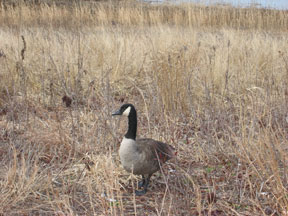August
2005
Jamaica
Bay Wildlife Refuge: An Urban Respite from the Concrete Jungle
By Sangamithra Iyer
|
|
|
|
Photos by Sangamithra
Iyer |
While many of us like to boast
the title New Yorker, few of us are truly native. By choice, chance,
or circumstance, we’ve adapted
to our urban surroundings to call this city our home—whether
it be temporary or permanent.
Though I’ve always had an affinity and respect for animals, I felt living
in NYC never allowed much opportunity for me to be around them. I thought you
had to travel long and far to remote places—or at least outside the five
boroughs—to experience ‘wilderness,’ not fully recognizing
or appreciating all the critters who also by choice, chance, or circumstance
make my city their home—whether it be temporary or permanent.
If you listen closely above the sounds of traffic, car alarms, sirens and general
hubbub, you can hear birds chirping in the street trees. And if you look closely,
your eyes can follow the paths of the subway rats and mice while you await the
next train. And if you spend more time in the city parks, you’d sense the
plethora of four-legged or two-winged critters hanging around.
But exposure to city critters doesn’t always have to be a peripheral or
underground experience. Did you know that New York City is home to one of largest
bird sanctuaries in the Northeast? Jamaica Bay Wildlife Refuge in Queens serves
as an important rest stop for migrating birds along the Atlantic flyway. The
refuge includes 9,155 acres of habitat with salt marshland, woods, ponds, and
an open expanse of bay and islands. It was established in 1951 by the NYC parks
department and transferred to the National Park Service in 1972 as part of the
Gateway National Recreation Area.
Initially created with the path of migratory birds in mind, the refuge also supports
a variety of mammals, reptiles, and amphibians: Opossums, bats, jackrabbits,
muskrats, chipmunks, turtles, snakes, frogs and butterflies call Jamaica Bay
their home.
Visitors can get to the refuge via car, subway or bus. If driving, you’ll
notice the stark change in scenery from the sprawling highway to the bay islands
as you cross the North Channel Bridge. Your first stop on the island should be
the visitor’s center, where you’ll receive a free hiking permit,
a site map, and a guide to the flora and fauna of the refuge. Parking is free.
There are two major trails you can follow—the West Pond and East Pond—to
observe critters. The West Pond trail is a 1.75-mile loop where you can see the
marshland set against the city sky. Birds aren’t the only winged objects
in flight you’ll observe. Situated in close proximity to JFK airport, you’ll
witness planes also competing for the sky.
Benches are readily available along the pond to sit and watch the waders and
waterfowl. You may encounter ducks, geese, gulls, or a peregrine falcon. Along
a portion of this trail, diamond back terrapin turtles lay their eggs. The end
of the trail is a more wooded area, containing red maple, gray birch, autumn
olive, and pine trees. Prickly pear cacti also thrive in this environment.
The East Pond trail located across the street from the visitor’s center
is less frequented—as it requires visitors to cross many lanes of highway—and
is more secluded. The three-mile trek around the pond is quite muddy and on some
days, portions of the trail are closed. Getting dirty is worth it though, as
you are likely to encounter the long and slender beaked glossy ibis, as well
as turtles and swans, along this trail.
Jamaica Bay Wildlife refuge is open year-round, and each season offers something
special. Winter is cold, but snowy owls, geese, and bufflehead ducks will give
you company. Along with warmer weather, the spring offers songbirds, wildflowers,
and the greening of the salt marsh. The summer brings waders like egrets and
herons and, when things cool down, shorebirds and hawks stop by in the fall.
While it is great to have this refuge in an urban environment, urbanization does
have considerable impact on the habitat. Extensive areas of the bay have been
dredged for navigation channels and fill material for the airports and other
construction projects. Sediment is being depleted faster than it can be replaced,
which threatens the survival of Jamaica Bay’s salt marshes. An experimental
marsh restoration project was launched in 2003 at Big Egg marsh at the southern
end of the refuge, to raise marshland and plant marsh grass. This may serve as
a model for other marsh restoration in the bay. While still being monitored,
the project seems to be working with little erosion observed so far. Wildlife
spottings of birds and crabs in the newly raised and planted areas are also an
indication of success.
So if you feel like going wild, throw on a pair of hiking boots, grab your camera,
hop on the subway and spend time with some furry and feathered New Yorkers. It’s
a nice escape from the city without escaping the city.
Jamaica Bay Wildlife Refuge visitor’s center is open year-round 8:30
a.m. to 5 p.m., and is located at Cross Bay Boulevard, Queens. The refuge is
accessible
by car, the A train to Broad Channel station, or the Q53 and Q21 buses. For information
call (718) 318-4340 or visit www.nps.gov/gate.
 |
|
|
 |


